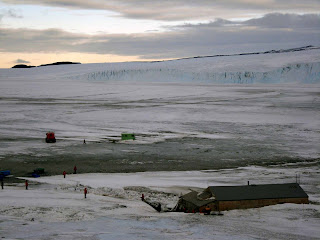In late February a large chunk (41 km x 2.4 km) of ice broke away from the Wilkins Ice Shelf on the Antarctic Peninsula. The break has triggered the breakup of much more of the ice shelf, so that now the whole ice shelf is in danger of disintegrating.

Here is an image taken during a flyover by the British Antarctic Survey:

Scientists attribute the breakup to global warming. Temperature records show that the region around the Antarctic Peninsula is warming at a faster rate than most other parts of the world. The breakup of the Wilkins shelf will not contribute directly to rising sea level. It's more like having an ice cube in a glass of water melt -- the water level remains the same. However, as ice shelves disappear, it's likely the glaciers behind them will begin to flow more quickly into the oceans. This phenomenon is being seen today in areas of Greenland. The melting of these glaciers will contribute to a sea level rise. Interestingly, there's enough water stored in the polar ice caps to cause a 70 m rise in global sea level!










